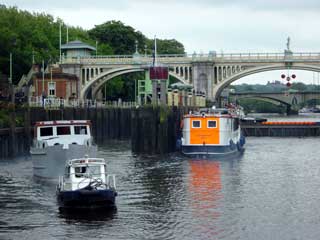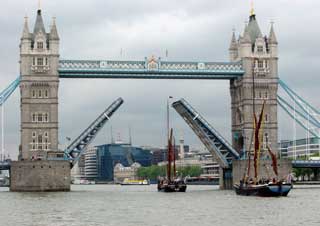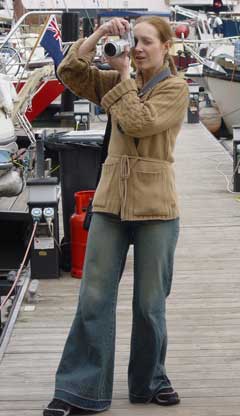Hampton Court to Limehouse
Friday 16th May
 We
had puzzled for ages over the forthcoming cruise downstream through the
tidal Thames. The combination of tide times, bridge heights and depth
of water led to a seemingly impossible conundrum. Our first problem was
that our passage was going to take place during an extreme spring tide.
The upper tidal reach of the Thames ebbs very slowly and floods very quickly
and so by the time the tide comes to Richmond its surge is not only difficult
to pinpoint because of other climatic influences but, within three to
four hours, you have caught up the highest of the tide when proceeding
downstream.
We
had puzzled for ages over the forthcoming cruise downstream through the
tidal Thames. The combination of tide times, bridge heights and depth
of water led to a seemingly impossible conundrum. Our first problem was
that our passage was going to take place during an extreme spring tide.
The upper tidal reach of the Thames ebbs very slowly and floods very quickly
and so by the time the tide comes to Richmond its surge is not only difficult
to pinpoint because of other climatic influences but, within three to
four hours, you have caught up the highest of the tide when proceeding
downstream.
 The
conventional wisdom is either to leave around high water or a little before,
in which case you can pass through Richmond without using the lock as
the sluices are open for free passage two hours either side of high tide.
You then gain the support of the tidal flow all the way downstream which
makes for a fast passage but you arrive below London Bridge at just about
low water, with no chance of gaining entrance to St Katherines or Limehouse
in a normal tide, let alone a spring tide. In addition, on the day of
our passage the high tide was at either 1am or 3pm, making for a night
passage, or late evening arrival. There seem to be few places convenient
and comfortable to wait in the tidal Thames and so this option only really
suits passages early in the day when the intention is to cruise on through
the tidal section and into the Thames esturary without stopping.
The
conventional wisdom is either to leave around high water or a little before,
in which case you can pass through Richmond without using the lock as
the sluices are open for free passage two hours either side of high tide.
You then gain the support of the tidal flow all the way downstream which
makes for a fast passage but you arrive below London Bridge at just about
low water, with no chance of gaining entrance to St Katherines or Limehouse
in a normal tide, let alone a spring tide. In addition, on the day of
our passage the high tide was at either 1am or 3pm, making for a night
passage, or late evening arrival. There seem to be few places convenient
and comfortable to wait in the tidal Thames and so this option only really
suits passages early in the day when the intention is to cruise on through
the tidal section and into the Thames esturary without stopping.
The second recommended option of setting off several hours after high water would still give sufficient water for depth in the upper section whilst giving plenty of headroom under the low Hammersmith bridge and would leave timings for Limehouse which are more convenient, but in our case on this particular day it would have meant leaving in the middle of the night, or far too late in the day to reach Limehouse within working hours.
 We
therefore worked out a plan of our own which seemed the only realistic
option for vessels of reasonable draught and height restrictions that
want to make Limehouse on a single tide. This involved getting to Richmond
at around low water and waiting for the first trip boats to come upstream
with the beginning of the flood. We then used the lock to pass downstream
at the first opportunity, without incurring any charge as it turned out.
Though punching the tide it was possible to get to Hammersmith an hour
and a half before high water, to provide at least a metre more than the
minimum bridge height advertised. We got the benefit of the ebb tide for
the last part of our passage and locked into Limehouse a couple of hours
after high water.
We
therefore worked out a plan of our own which seemed the only realistic
option for vessels of reasonable draught and height restrictions that
want to make Limehouse on a single tide. This involved getting to Richmond
at around low water and waiting for the first trip boats to come upstream
with the beginning of the flood. We then used the lock to pass downstream
at the first opportunity, without incurring any charge as it turned out.
Though punching the tide it was possible to get to Hammersmith an hour
and a half before high water, to provide at least a metre more than the
minimum bridge height advertised. We got the benefit of the ebb tide for
the last part of our passage and locked into Limehouse a couple of hours
after high water.
 We
were lucky to miss most of the rain whilst we had the canopy lowered for
the bridges and reassembled our canopy for the last time for a while with
some relief. We were glad to relax in the safety of the marina and planned
to stay for the weekend to enjoy some rest and relaxation before continuing
our passage onto the south coast.
We
were lucky to miss most of the rain whilst we had the canopy lowered for
the bridges and reassembled our canopy for the last time for a while with
some relief. We were glad to relax in the safety of the marina and planned
to stay for the weekend to enjoy some rest and relaxation before continuing
our passage onto the south coast.
Our technique of setting up a height gauge on the pulpit paid dividends with the numerous bridges on this stretch of the Thames even though we had the excellent photocopied guides provided by the Limehouse lockkeeper which identified each of the bridges, their heights and navigable spans.
Cruising Statistics
Distance:22 nm
Total to date: 385 nm
Avg Speed: 5 knots
Duration: 5 hours
Wind: SW 3
Mooring: £15/night
Electricity: £2.50/night
Locks
Teddington
Richmond
Limehouse
Bridges
Kingston 23'11
Teddington 18'4
Richmond road 19'10
Richmond rail 20'8
Twickenham 22'6
Kew road 20'
Kew railway 20'5
Chiswick 25'
Barnes 20'2
Hammersmith 15'
Putney 20'
Fulham 24'5
Wandsworth 21'
Battersea 22'
Albert 19'11
Chelsea 24'
Victoria 21'5
Vauxhall 20'4
Lambeth 22'6
Westminster 19'6
Charing Cross 24'9
Waterloo 28'6
Blackfriars 24'1
Blackfriars rail 24'6
Southwark 25'6
Canon St 24'11
London 25'6
Tower 30'